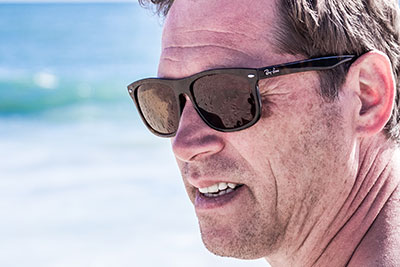Facial Skin Cancer
The upper face and eyelids are unique in that they are not only a common site for skin cancers, but skin cancers in this region tend to be aggressive subtypes (ie like an iceberg).
Lesions in this area are ideally treated with margin control whereby margins of excision are checked at the time of surgery prior to reconstruction. This is performed by Frozen Section for simple lesions or Mohs Micrographic surgery for lesions with high risk features. Reconstruction can then occur once the margins of the lesion have been shown to be clear. The eye has two important layers that need to be reconstructed separately. The posterior layer/structural layer of the eyelid must have a mucosal surface (as in contact with the eye). The anterior layer is composed of skin and muscle. Sites for harvesting tissue to replace the posterior layer include the eyelid, nose, hard palate or ear cartilage. The anterior lamella is the skin/muscle layer which is often corrected with a skin/muscle flap or skin grafting.
Defects elsewhere on the face tend to be skin only or skin and muscle which are often corrected with skin/muscle (myocutaneous) flaps. The benefit of flaps to skin grafts is that they already have a blood supply and so failure is rare. Also, wounds can be hidden within aesthetic borders and so achieving a cosmetically superior outcome. For aggressive lesions with certain characteristics, additional treatment such as radiotherapy, chemotherapy or lymph node sampling may be required.
Periocular and Facial Malignancies
Ideal management consists of both complete excision of the tumour and then appropriate reconstruction of the defect post excision. Given the intricate and protective nature of the eyelid and midface to the eye, reconstruction requires specialist oculoplastic techniques to optimise both functional and aesthetic outcomes.
The eyelid and surrounding strucutres are considered high risk for skin malignancies as aggressively behaving lesions occur in this particular area, often with extension beyond the visible borders (like an iceberg).
Removal of the lesion with margin control at the time of surgery is therefore critical to prevent morbidity from recurrence. The two most common methods to ensure margin control whilst minimising tissue loss are:
Frozen Section - The lesion is removed and sent to a pathologist while the patient is placed in recovery. The pathologist may take an hour or so to examine concerning margins of the specimen. Depending on the pathological findings, the patient is brought back to theatre for reconstruction or excision of further tissue. This technique is applicable to many primary eyelid lesions.
Mohs Micrographic Surgery - A dermatologist will take serial sections of the lesion, examined in real time by a pathologist and mapped until the entire lesion is excised. The defect can then be reconstructed. This is the gold standard for lesions which have poorly demarcated margins, are recurrent, high grade or in high risk areas. This technique is only available in the private sector.
Eyelid Lumps and Bumps (Benign eyelid lesions)
The eyelids are particularly prone to developing blocked glands, cysts and benign tumours. These lesions may cause irritation, be of cosmetic concern or pose a diagnostic dilemma as may masquerade as something more sinister,
Where there is a diagnostic concern, the lesion is sufficiently bothersome or functional impairment exists, excision may be warranted. This can usually be performed in rooms under local anaesthetic or on occasion may be required to be perfomed in theatre.


